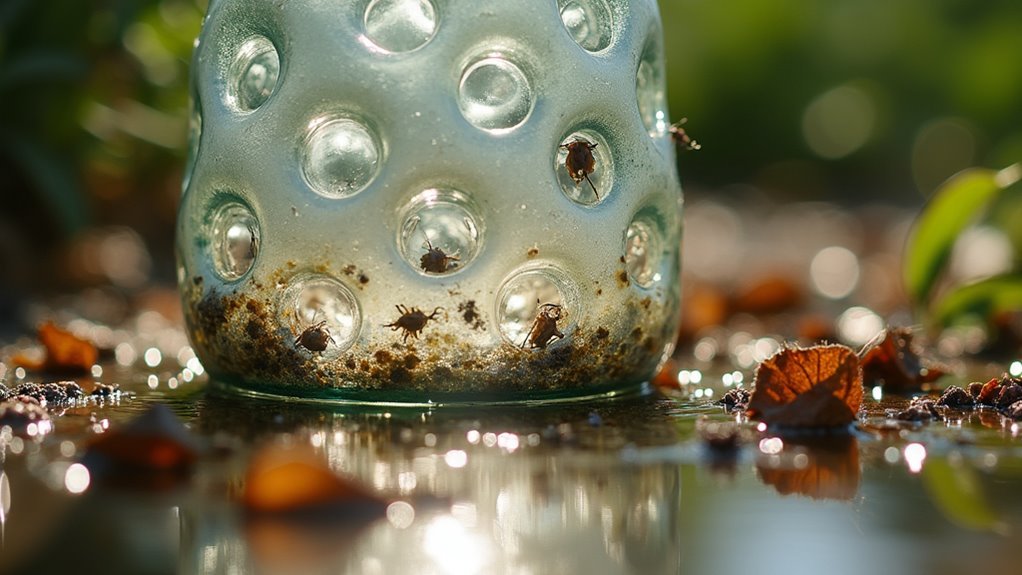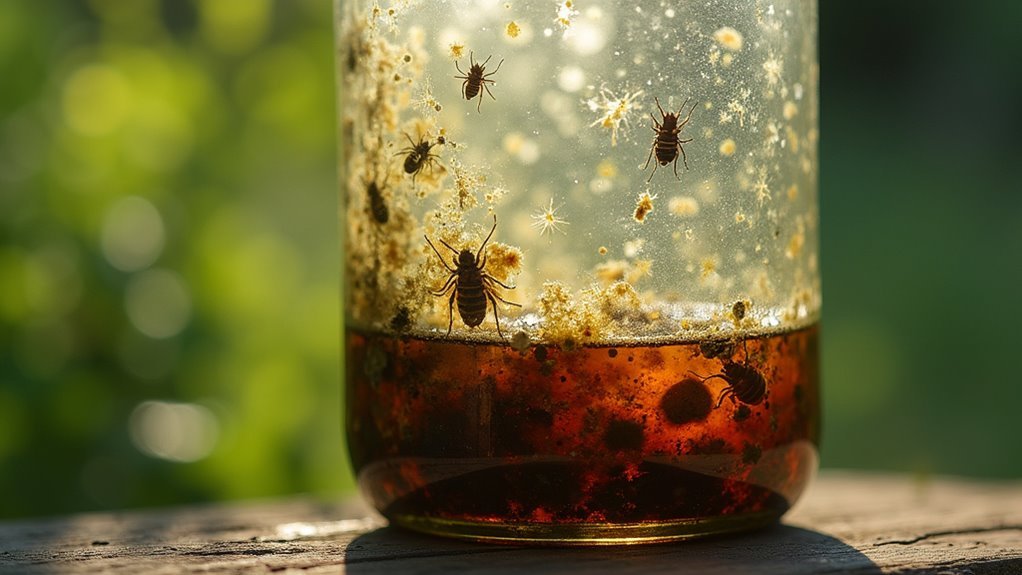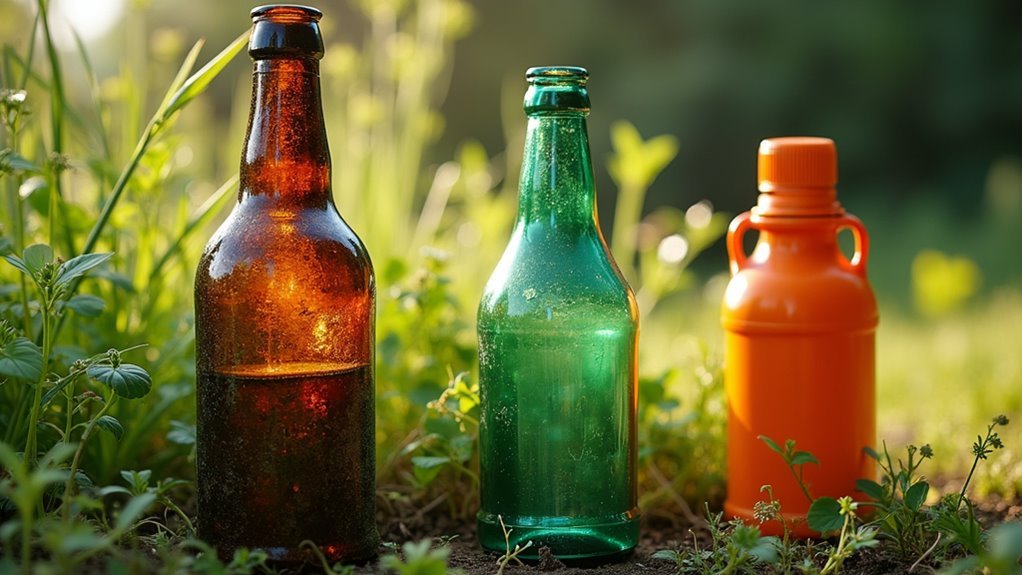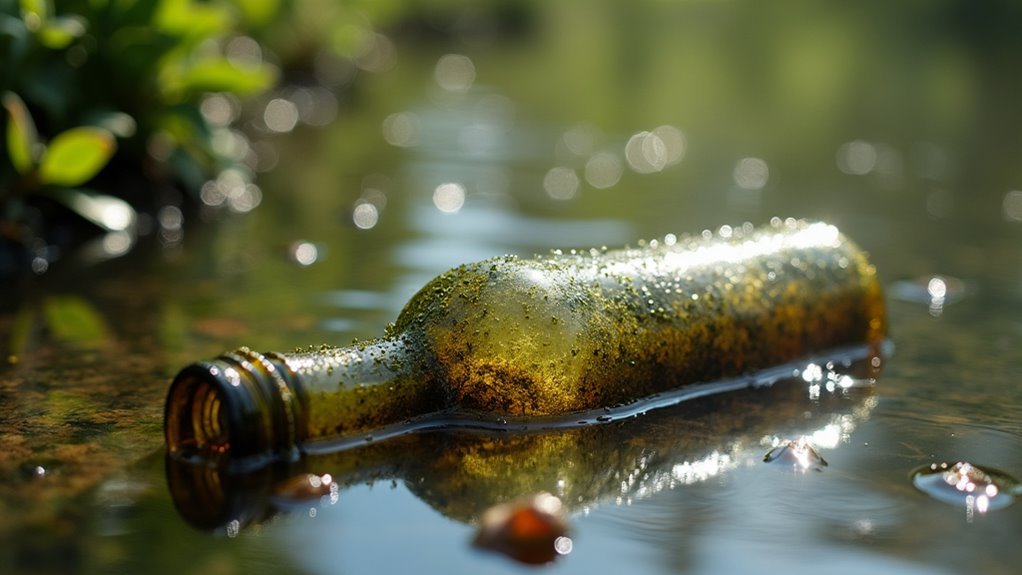Your homemade bottle trap is failing because it lacks self-scouring capability, allowing debris to accumulate and create frequent blockages. The irregular design prevents proper water flow velocity and complicates mechanical clearing with standard tools. You’re risking dangerous sewer gas exposure when water seals break down, plus potential legal violations since many codes prohibit bottle traps. These design flaws lead to higher maintenance costs and safety hazards that proper alternatives could prevent entirely.
Design Flaws That Compromise Drainage Performance

While bottle traps may seem like an attractive DIY plumbing solution, their internal design creates fundamental flaws that compromise your drainage system’s performance.
You’ll discover that these traps lack the self-scouring capability essential for maintaining clear drainage, causing debris to accumulate and create persistent blockages.
When you make sure to examine their construction closely, you’ll notice the design prevents proper water flow velocity needed to flush away waste effectively.
The irregular shape also means you can’t easily clear mechanical blockages when problems arise.
Even if you add a little extra maintenance effort, the fundamental design prevents ideal drainage flow.
This combination of poor self-cleaning action and difficult maintenance access creates a drainage system that’s prone to frequent failures and reduced performance over time.
Safety Risks From Sewer Gas Exposure
Beyond the drainage issues, homemade bottle traps pose serious health hazards when their water seals fail and allow toxic sewer gases to infiltrate your living spaces.
The internal partition within these traps is particularly vulnerable to failure, which breaks the protective water barrier that keeps dangerous gases at bay.
You’re exposing yourself to significant risks when you rely on these problematic devices:
Using unreliable bottle traps puts your household at unnecessary risk from toxic gas exposure and potential health complications.
- Compromised water seals from poor design lead to direct backflow of harmful sewer gas into your home
- Accumulating waste without self-scouring capabilities increases blockage likelihood and subsequent gas leaks
- Legal violations in many regions where bottle traps are banned due to documented safety concerns
The aesthetic appeal simply can’t justify these serious health risks to your family’s wellbeing.
Maintenance Challenges and Self-Scouring Problems

Although bottle traps may seem convenient, their fundamental design flaws create ongoing maintenance nightmares that’ll drain your time and wallet.
You’ll quickly discover that bottle traps lack self-scouring capacity, making them magnets for clogs and debris accumulation. Unlike conventional traps that naturally flush waste through flowing water, bottle traps can’t clean themselves effectively.
When blockages occur, you’ll face mechanical clearing challenges due to their complex internal partition design. The awkward shape makes standard drain cleaning tools ineffective, often forcing you to completely disassemble the trap for proper cleaning.
This tedious process becomes a recurring burden as debris continues building up without proper maintenance.
Without self-cleaning features, you’re looking at higher long-term maintenance costs and constant reliability issues that conventional trap designs simply don’t present.
Legal Compliance Issues With Local Plumbing Codes
Before you install a homemade bottle trap, you’ll need to verify that local plumbing codes actually permit their use in your jurisdiction.
Most municipalities strictly prohibit bottle traps because they can’t prevent sewer gas from entering your living spaces, creating serious health hazards for your family.
You’re facing significant legal and financial risks when you install non-compliant plumbing fixtures:
- Monetary penalties and fines from code enforcement officials during inspections
- Mandatory removal and replacement costs when violations are discovered
- Legal liability exposure if health issues or property damage occur
Local codes emphasize durability and reliability in plumbing installations.
Bottle traps rarely qualify for variances, and their poor self-scouring capabilities violate standards designed to minimize maintenance problems and guarantee long-term safety.
Reliable Alternatives for Long-Term Performance

When you’re ready to install a compliant drain trap, several proven alternatives deliver the reliability and code compliance that homemade bottle traps can’t match.
PVC and chrome-plated brass traps offer superior durability while meeting plumbing code requirements. These materials resist corrosion and maintain their water seal over time.
For tight installation spaces, you’ll find tubular traps provide excellent functionality without compromising performance. They’re specifically engineered to prevent sewer gas exposure while fitting into cramped areas.
Conventional traps outperform decorative bottle traps through their self-scouring capabilities, which eliminate maintenance headaches. This design prevents debris buildup that commonly clogs bottle-style traps.
Investing in high-quality trap fixtures guarantees long-term performance and reduces repair frequency. You’ll save money and avoid the safety risks associated with homemade solutions.
Frequently Asked Questions
What Is the Problem With Bottle Traps?
You’ll face sewer gas leaks when bottle traps’ internal partitions fail. They can’t self-clean like conventional traps, causing frequent clogs. You can’t easily clear blockages mechanically, and many regions legally prohibit them.
Why Are S Traps Not Allowed Anymore?
S traps aren’t allowed because they’ll siphon water from your drain, eliminating the water seal that blocks sewer gases. You’ll face failed inspections and health hazards from toxic fumes entering your home.
Why Are Bottle Traps Illegal in America?
You’ll find bottle traps illegal in America because they can’t self-scour properly, making them clog easily. They’re unreliable at preventing dangerous sewer gas from entering your home, violating safety codes.
Are Bottle Traps Against Code?
You’ll find bottle traps violate most American plumbing codes because they don’t meet safety standards. They can’t self-scour properly and risk internal partition failure, potentially exposing you to dangerous sewer gases.
In Summary
You’ve seen how homemade bottle traps create more problems than they solve. Their poor design leads to drainage failures, while gas leaks threaten your family’s health. You’ll struggle with constant maintenance, and you’re likely violating local codes. Don’t risk expensive repairs or safety hazards. Instead, invest in professionally manufactured P-traps or consult a licensed plumber. You’ll save money long-term and guarantee your plumbing system works reliably for years to come.





Leave a Reply